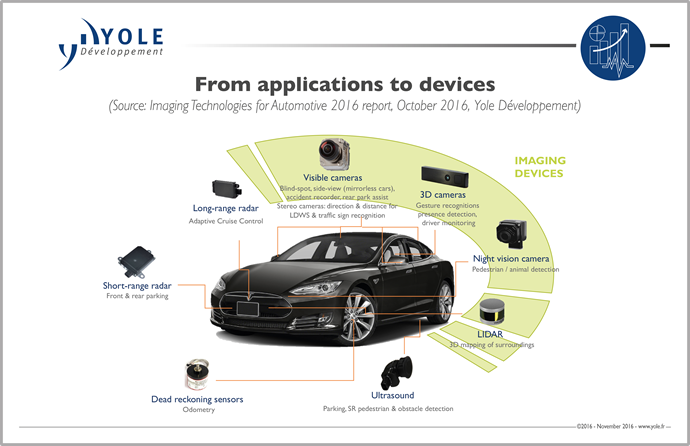It’s all about the image – the tech that’s transforming the automotive industry
New research from Yole Développement (Yole) has indicated that imaging technology is playing an increasing integral role within the automotive sector, contributing to an estimated 20% CAGR (compound annual growth rate), between 2015 and 2021.
Amongst the nine market segments identified by Yole’s analysts, ADAS cameras are the most important and will represent 51% in revenue in 2021. ‘For Display’ cameras are also a critical application that will foster the development of imaging technologies.
Yole has published a technology and market report dedicated to the imaging technologies for automotive applications. Titled Imaging Technologies for Automotive 2016. Yole’s analysts detail the related ecosystem and describe the competing landscape. Covering visible cameras, solid state lidars, LWIR cameras and 3D cameras, this report presents a technology roadmap from 2015 to 2021.
Capitalising on innovative technologies initially developed for smartphones, electronics has invaded step by step into the automotive sector. Today, imaging technologies are taking centre stage. “From less than one camera per car on average in 2015, there will be more than three cameras per car by 2021”, announced Pierre Cambou, Activity Leader, Imaging at Yole. “It means 371 million automotive imaging devices”.
Cameras were initially mounted for ADAS purposes on high end vehicles, with deep learning image analysis techniques promoting early adoption. “The Israeli company Mobileye has been instrumental in bringing this technology to market, along with ON Semiconductor, which provided the
CMOS image sensor,” commented Dr Eric Mounier, Senior Analyst at Yole. He added: “Copycat competition will probably pick up as the market now justifies initial investment in design and technology.” It is now a well established fact that vision-based AEB is possible and saves lives. Adoption of forward ADAS cameras will therefore accelerate.

Growth of imaging for automotive is also being fuelled by the park assist application, and 360° surround view camera volume is therefore skyrocketing. While it’s becoming mandatory in the US to have a rearview camera by 2018, that uptake is dwarfed by 360° surround view cameras, which enable a ‘bird’s eye view’ perspective.
Mirror replacement cameras are currently the big unknown and take-off will primarily depend on its appeal and car design regulation. Solid state lidar is well talked about and will start to be found in high end cars by 2021. Cost reduction will be a key driver as the push for semi-autonomous driving will be felt more strongly by car manufacturers.
LWIR technology-based night vision cameras were initially perceived as a status symbol. However, they’re increasingly appreciated for their ability to automatically detect pedestrians and wildlife. LWIR solutions will therefore become integrated into ADAS systems in future. From their side, 3D cameras will be limited to in-cabin infotainment and driver monitoring. This technology will be key for luxury cars and therefore is of limited use today.


